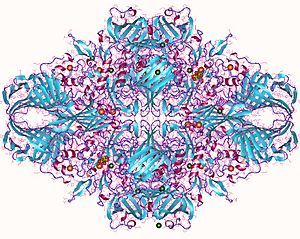Lactase facts for kids
Lactase is a special enzyme (a type of protein). It helps your body break down lactose. Lactose is the main sugar found in milk. When lactase breaks down lactose, your body can then use the sugar for energy.
Contents
Lactase in Mammals
Most baby mammals, like puppies or kittens, produce lactase. They need it to digest their mother's milk. Milk is their main food source when they are young.
However, as mammals grow into adults, most of them stop making lactase. This means they can't digest milk sugar anymore. For example, if an adult cat drinks milk, it might get an upset stomach or diarrhea.
Lactase in Humans
Humans are a bit different from most other mammals. Some people continue to make lactase even as adults. Other people stop making it, just like most other adult mammals. This difference is called a polymorphism, meaning there are different forms of a trait in a population.
The ability to digest lactose as an adult is called 'lactase persistence'. This ability became very helpful to humans after they started animal husbandry. This is when people began to farm animals like cows and goats for their milk. Having a steady supply of milk meant that people with lactase persistence had a new food source.
Before farming became common, most people were not able to digest lactose as adults. Even today, many groups of people who live like ancient hunter-gatherers cannot digest lactose as adults.
How Lactase Persistence Evolved
Scientists have found that a small change, called a mutation, on chromosome #2 allows some people to keep making lactase. This mutation stops the body from turning off lactase production. People with this mutation can drink fresh milk and eat other dairy products throughout their lives without problems.
This ability to digest milk as an adult is a recent adaptation in human history. It seems to have developed on its own in different parts of the world. For example, it appeared in northern Europe and in East Africa. These were places where people had a pastoral lifestyle, meaning they raised animals for milk.
Lactase persistence is a dominant trait. This means that if you get just one copy of the gene for lactase persistence from either parent, you will likely be able to digest lactose as an adult. Not being able to digest lactose (lactose intolerance) is a recessive trait.
Genetic studies show that the mutations for lactase persistence became common in human populations only in the last 10,000 years. This is why it's often used as an example of recent human evolution. Since lactase persistence is genetic, but farming is a cultural practice, this is an example of gene–culture coevolution. It means genes and culture influenced each other's development.
Related pages
Images for kids
See also
 In Spanish: Lactasa para niños
In Spanish: Lactasa para niños


